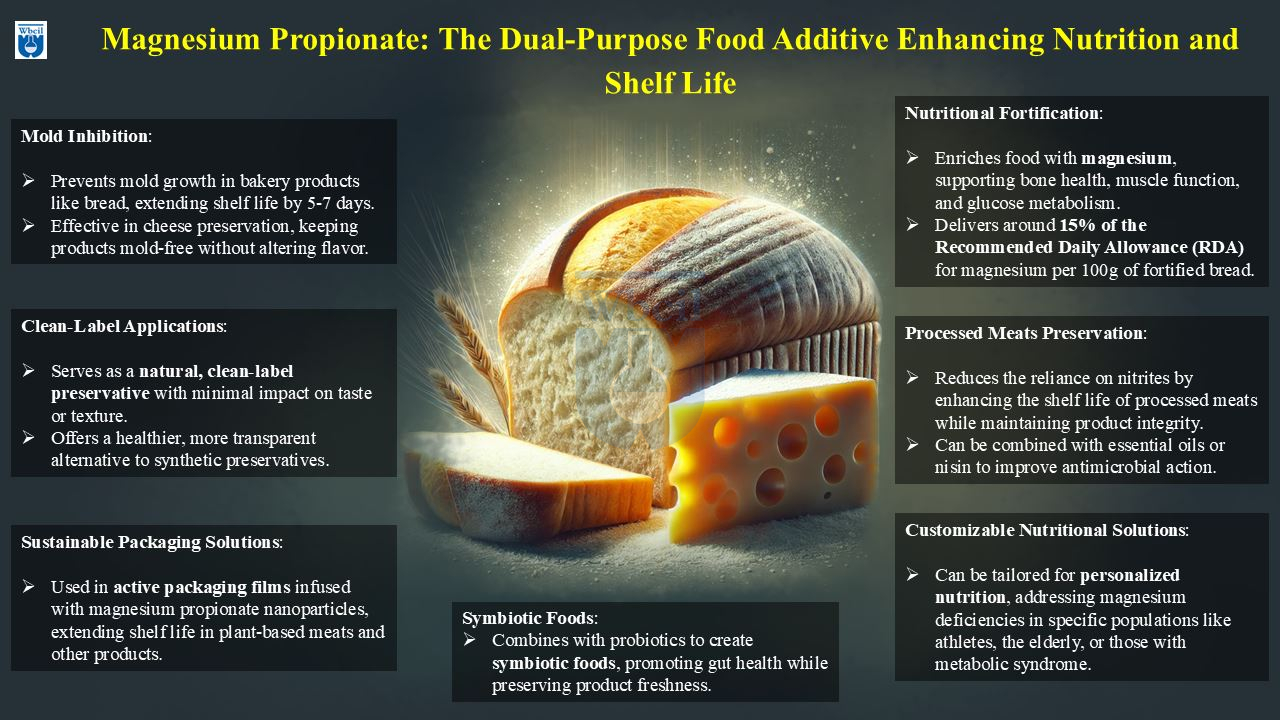Magnesium Propionate: The Dual-Purpose Food Additive Enhancing Nutrition and Shelf Life
Imagine a silent guardian in your pantry, a mineral-based food preservative that battles spoilage while fortifying your diet with essential nutrients. While 30% of global food production succumbs to waste, magnesium propionate emerges as a dual-action hero. This GRAS-approved propionate preservative not only extends shelf life but also delivers magnesium, a vital mineral often lacking in modern diets.
In food science, magnesium propionate is a game-changer, seamlessly blending preservation with nutrition. As industries pivot toward clean-label solutions, the magnesium propionate food additive is gaining traction for its ability to enhance both product longevity and consumer health. This blog explores magnesium propionate’s chemical prowess, applications, and why it’s a rising star in the quest for sustainable, nutritious food.
What is Magnesium Propionate?
Magnesium propionate, a soluble magnesium salt, is a white crystalline powder that quietly revolutionizes food preservation and nutrition. Its chemical profile—formula C₆H₁₀MgO₄, CAS 557-27-7—reveals a neutral pH and odorless nature, making it a versatile propionate preservative. Synthesized through the reaction of propionic acid and magnesium hydroxide, magnesium propionate undergoes rigorous purification via crystallization and filtration, ensuring purity for food applications. Recognized as a GRAS additive by the FDA, magnesium propionate enjoys global approval from regulatory bodies like the EU and WHO, cementing its status as a trusted mineral-based food preservative. Whether inhibiting mold or enriching diets, magnesium propionate’s composition makes it a cornerstone of modern food science.
Magnesium Propanoate Formula and Production
The magnesium propanoate formula, C₆H₁₀MgO₄, results from a precise chemical dance: propanoic acid + magnesium equation yields this potent compound. Its production is both sustainable and scalable, aligning with the demand for clean-label preservatives.
Preservation Powerhouse
Magnesium propionate is a mold inhibitor par excellence, acting like a sentinel guarding food against microbial invaders. As a propionic acid preservative, it disrupts yeast and mold cell membranes, halting spoilage at concentrations as low as 0.1-0.3% by weight. Unlike sodium benzoate, magnesium propionate boasts broad-spectrum antimicrobial activity, outperforming even calcium propionate in diverse pH ranges (3-9). Its pH neutrality makes it ideal for bakery, dairy, and processed meats, where it extends magnesium propionate shelf life by 5-7 days in bread and prevents mold in cheeses without altering flavor. Synergizing with nisin or essential oils, magnesium propionate enhances preservation, reducing reliance on nitrites in meats.
Comparison of Common Food Preservatives
| Preservative | Antimicrobial Spectrum | pH Range | Nutritional Value |
| Magnesium Propionate | Broad | 3-9 | Magnesium source |
| Sodium Benzoate | Narrow | 2.5-4.0 | None |
| Calcium Propionate | Moderate | 5-8 | Calcium source |
This table underscores why magnesium propionate is a preferred propionate preservative, blending efficacy with nutritional benefits.
Nutritional Benefits of Magnesium Propionate
Magnesium propionate is more than a clean-label preservative; it’s a nutritional powerhouse. Magnesium, a cofactor in over 300 enzymatic reactions, supports bone density, muscle function, and glucose metabolism. A 100g slice of magnesium propionate-fortified bread delivers ~15% of the Recommended Daily Allowance (RDA) for magnesium, rivaling the bioavailability of magnesium citrate or glycinate. Athletes benefit from magnesium propionate’s role in muscle recovery, while the elderly find support for bone health. For those with metabolic syndrome, magnesium propionate health benefits include improved glucose regulation. By embedding magnesium in everyday foods, this propionate preservative addresses widespread deficiencies, making it a vital tool for public health.
Magnesium Propionate Bioavailability
Studies confirm magnesium propionate’s high bioavailability, ensuring its nutritional payload is effectively absorbed, unlike some synthetic food preservatives.

Dual-Action Innovation
Picture a loaf of whole-grain bread that resists mold for 14 days while delivering 20% of your daily magnesium. This is the promise of magnesium propionate, as demonstrated in a case study of fortified bread. Consumer trials reported 92% satisfaction, with no detectable taste difference, highlighting magnesium propionate’s clean-label appeal.
For manufacturers, magnesium propionate uses offer cost savings by combining preservation and fortification in one ingredient, reducing the need for separate additives. WBCIL’s magnesium propionate, produced by West Bengal Chemical Industries, exemplifies this innovation, meeting the demand for sustainable, nutrient-rich foods. As a propionate preservative, magnesium propionate is reshaping the food industry’s approach to clean-label solutions.

observed below 3% dietary intake, and global labeling requirements—such as E-number E283—ensure transparency. For children, magnesium propionate is safe within recommended limits, though consulting a pediatric nutritionist is advised. Compared to calcium propionate, magnesium propionate offers similar preservation but swaps calcium for magnesium, catering to different nutritional needs. Its safety profile reinforces magnesium propionate’s role as a trusted GRAS additive.
Future Trends of Magnesium Propionate
The future of magnesium propionate is bright, with a projected 8.7% CAGR growth from 2025 to 2030. Sustainable production methods, such as bio-based propionic acid, align with eco-conscious trends. Personalized nutrition is another frontier, where magnesium propionate could be tailored to individual dietary needs. As a mineral-based food preservative, magnesium propionate is set to dominate the clean-label preservative market, driven by consumer demand for health-focused, sustainable foods. WBCIL’s food additive magnesium propionate is at the forefront, paving the way for a healthier, longer-lasting food supply.
